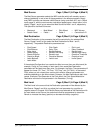
Editing Effects: Chapter 7
DELAY
The Delay function is used to edit Delay parameters. The QS’s effects processor has
three different Delay types available.
Note: Some Configurations only feature a mono Delay, and therefore the Delay Type
parameter will be unavailable. Instead the parameters normally found on page 2 of
the Delay function are shown in page 1, and there are no other pages (please refer to
next section for a description of those parameters).
Delay Type (3 types) Page 1
Ping-Pong. This is called a “Ping Pong Delay” because the output bounces from side
to side (left to right) in stereo with the speed determined by the delay time. The
maximum delay time is 399 milliseconds.
Stereo Delay. The Stereo Delay is actually two separate delays, which can be
individually varied. The maximum delay time for each delay is 399 ms.
Mono. The Mono Delay has the advantage of twice the available delay time, or 799
ms in Configuration #1, 1199 ms in Configuration #2.
In Pages 2 through 5 of the Delay Function you will find the remaining parameters for
the Delay function. If the Stereo Delay type is selected, you can use [PAGE ] to
advance through pages 6 – 8. This is because the Stereo Delay type has parameters
for both the Left and Right channels.
Input (<99 to <0> to 99>) Page 2
This parameter is used to balance the Delay Input between the signal coming from
the Pitch effect output (if applicable in the selected Configuration) and the dry effect
send.
Time (0 to 799ms total) Pages 3 & 4 (and 6 & 7 in Stereo Delay)
This is the actual Delay time, which determines the amount of time the input signal
will be delayed. The Stereo and Ping Pong Delay types can have a delay time of up
to 399ms. However, the Mono Delay can have up to 799ms per channel. Use Page 3
to adjust the delay time in 10 ms intervals; use page 4 to adjust the delay time in 1
ms intervals. When using the Stereo Delay, pages 3 & 4 let you adjust the delay time
of the left channel, while pages 6 & 7 let you adjust the same for the right channel.
Feedback (00 to 99) Page 5 (and Page 8 in Stereo Delay)
This adjusts the Delay Feedback, which is a portion of the delay signal output being
“fed back” into the input. This results in the delay repeating itself. The more feedback,
the more repeats. When using the Stereo Delay, page 5 lets you adjust the feedback
level of the left channel, while page 8 lets you adjust the same for the right channel.
QS7/QS8 Reference Manual 105


















